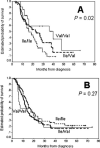Glutathione S-transferase gene polymorphisms and risk and survival of pancreatic cancer
- PMID: 17265526
- PMCID: PMC1892189
- DOI: 10.1002/cncr.22468
Glutathione S-transferase gene polymorphisms and risk and survival of pancreatic cancer
Abstract
Background: Pancreatic cancer is a multifactorial disease with metastasis-prone and therapy-resistant nature. The authors hypothesized that genetic variants of glutathione S-transferase (GST) affect detoxification of carcinogens and anticancer agents in the human pancreas and, thus, the risk and survival of pancreatic cancer.
Methods: Genotypes of GSTM1, GSTT1, and GSTP1 were determined in 352 patients with pancreatic ductal adenocarcinoma and in a control group of 315 healthy, non-Hispanic whites (frequency-matched by age and sex). Survival analysis was performed in a subset of 290 patients. Epidemiological and clinical information was obtained. A multiple unconditional logistic regression model, a Cox proportional hazards model, and log-rank tests were used for statistical analysis.
Results: No significant main effects of any of 3 GST genes on the risk of pancreatic cancer were observed. Subgroup analysis showed that older individuals (aged >or=62 years) who carried the GSTP1*C ((105)Val-(114)Val) containing genotype tended to have a reduced risk compared with younger individuals who carried the non-*C genotype (for sex and pack-years of smoking, the adjusted odd ratio was 0.54; 95% confidence interval [95% CI], 0.29-1.02). In a survival analysis of 138 patients who received 5-flurorouracil, patients who carried the GSTP1*C containing genotype had a significantly longer survival than patients who carried the non-*C genotype (multivariate hazard ratio, 0.45; 95% CI, 0.22-0.94).
Conclusions: The GSTP1*C variant conferred a possible protective effect against pancreatic cancer in older individuals and a significant survival advantage in patients who received 5-florouracil. The current findings must be confirmed before further inferences can be made.
Figures

Similar articles
-
Association of genetic polymorphism of glutathione S-transferase (GSTM1, GSTT1, GSTP1) with bladder cancer susceptibility.Urol Oncol. 2013 Oct;31(7):1193-203. doi: 10.1016/j.urolonc.2011.11.027. Epub 2011 Dec 11. Urol Oncol. 2013. PMID: 22154357
-
GSTA1, GSTM1, GSTP1, and GSTT1 polymorphisms and susceptibility to smoking-related bladder cancer: a case-control study.Urol Oncol. 2013 Oct;31(7):1184-92. doi: 10.1016/j.urolonc.2011.08.005. Urol Oncol. 2013. PMID: 24075358
-
GSTM1, GSTT1, and GSTP1 polymorphism and lung cancer risk in relation to tobacco smoking.Cancer Lett. 2004 May 10;208(1):65-74. doi: 10.1016/j.canlet.2004.01.002. Cancer Lett. 2004. PMID: 15105047
-
Glutathione S-transferase M1, T1 and P1 polymorphisms: susceptibility and outcome in lung cancer patients.J Exp Ther Oncol. 2008;7(1):73-85. J Exp Ther Oncol. 2008. PMID: 18472644
-
Genetic polymorphisms of glutathione-S-transferase genes (GSTM1, GSTT1 and GSTP1) and upper aerodigestive tract cancer risk among smokers, tobacco chewers and alcoholics in an Indian population.Eur J Cancer. 2007 Dec;43(18):2698-706. doi: 10.1016/j.ejca.2007.07.006. Epub 2007 Aug 17. Eur J Cancer. 2007. PMID: 17707637
Cited by
-
GSTP1 as a potential predictive factor for adverse events associated with platinum-based antitumor agent-induced peripheral neuropathy.Oncol Lett. 2019 Mar;17(3):2897-2904. doi: 10.3892/ol.2019.9907. Epub 2019 Jan 8. Oncol Lett. 2019. PMID: 30854066 Free PMC article.
-
Genetic Polymorphisms in Glutathione S-Transferase (GST) Gene and Their Correlation with Toxicity of Chemotherapy in Breast Cancer Patients.Asian Pac J Cancer Prev. 2024 Jul 1;25(7):2271-2282. doi: 10.31557/APJCP.2024.25.7.2271. Asian Pac J Cancer Prev. 2024. PMID: 39068558 Free PMC article.
-
An overview of genetic polymorphisms and pancreatic cancer risk in molecular epidemiologic studies.J Epidemiol. 2011;21(1):2-12. doi: 10.2188/jea.je20100090. Epub 2010 Nov 6. J Epidemiol. 2011. PMID: 21071884 Free PMC article. Review.
-
The -409 C/T genotype of PRSS1 protects against pancreatic cancer in the Han Chinese population.Dig Dis Sci. 2012 Feb;57(2):573-9. doi: 10.1007/s10620-011-1893-6. Epub 2011 Sep 16. Dig Dis Sci. 2012. PMID: 21922221
-
Gene-by-Environment Interactions in Pancreatic Cancer: Implications for Prevention.Yale J Biol Med. 2015 Jun 1;88(2):115-26. eCollection 2015 Jun. Yale J Biol Med. 2015. PMID: 26029010 Free PMC article. Review.
References
-
- American Cancer Society . Cancer Facts and Figures: 2006. American Cancer Society; Atlanta, Ga: 2006.
-
- Ries L, Eisner M, Kosary C, Hankey B, Miller B, Clegg L. SEER Cancer Statistics Review, 1975-2002. National Cancer Institute; Bethesda, Md: 2005.
-
- Li D, Jiao L. Molecular epidemiology of pancreatic cancer. Int J Gastrointest Cancer. 2003;33:3–14. - PubMed
-
- Hayes JD, Flanagan JU, Jowsey IR. Glutathione transferases. Annu Rev Pharmacol Toxicol. 2005;45:51–88. - PubMed
-
- Landi S. Mammalian class theta GST and differential susceptibility to carcinogens: a review. Mutat Res. 2000;463:247–283. - PubMed
Publication types
MeSH terms
Substances
Grants and funding
LinkOut - more resources
Full Text Sources
Medical
Research Materials
Miscellaneous

